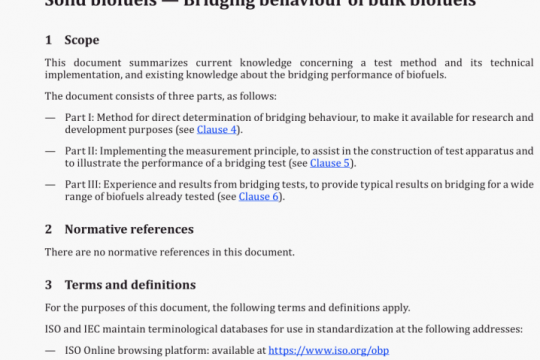BS ISO 16632 pdf free download
BS ISO 16632-2021 pdf free download.Tobacco and tobacco products一Determination of water content一Gas-chromatographic method.
6 Apparatus
Usual laboratory apparatus and, in particular, the following items.
All glassware used in the preparation and in the water determination shall be prepared to remove any water residue. Volumetric glassware shall be air-dried and stored in a desiccator over desiccant (h) until used. All other glassware shall be heated at (105 ± 5) °C for at least 1 h after visible water has evaporated. The glassware shall then be cooled and stored in a desiccator over desiccant (5k) until used.
6.1 Extraction vessels, for example ofcapacity 125 ml, dry serum bottles with crimp caps, or conical flasks with ground glass lids, or equivalent.
It is especially important to have excellent seals to prevent water absorption from air exposure.
6.2 Shaker, preferably horizontal, but wrist-action acceptable.
6.3 Disposable syringes, equipped with membrane filters with 0,45 tm pore size, ür equivalent.
6.4 Volumetric flasks, for example of capacities 100 ml and 500 ml, necessary for the preparation of the water stock solution (5.7.2) and the calibration standard solutions (5.7.3).
6.5 Gas chromatograph, equipped with a thermal conductivity detector, autosampler, and data acquisition system.
6.6 Column, a PLOT fused silica column has been demonstrated to be acceptable with PoraPLOT
U2) stationary phase (20 .im film thickness), 25 m in length with 0,53 mm internal diameter (see also
Clause 11).
6.7 Hot-air oven, capable ofmaintaining a temperature of(105 ± 5) °C.
7 Sampling
Sampling is conducted such that the laboratory test sample is representative of the population to be tested.
8 Procedure
8.1 Sample handling
It is recommended to combine and mix enough retail units to constitute at least 100 g for each test subsample. If size reduction is employed, the sample should be cut sufficiently small to pass through a 4 mm screen. The sample may be frozen with liquid nitrogen before cutting if the absolute moisture level is ofinterest. Cut filler from cigarettes need not be reduced further in size.
8.2 Sample preparation
Allow for adequate head space in the extraction vessel to increase extraction efficiency.
The sample weight and extraction volume may be adjusted on condition that it does not affect the determ i nation.
2) PoraPLOT U with 20 pm film thickness is an example of a suitable product commercially available. This information is given for the convenience ofusers ofthis document and does not constitute an endorsement by ISO of this product. Equivalent columns may be used if they can be shown to lead to the same results, i.e. that the analytes and internal standards are sufficiently resolved from interferences.
Weigh (5,0 ± 0,25) g of the sample (ed) into the dry extraction vessel (1). Record the weight to the nearest 0,000 1 g. It is recommended that a minimum oftwo test portions be prepared and analysed for each test sample.
The recommended procedure for portioned products such as snus is to analyse the entire portion by cutting the pouch in halfand adding the tobacco and pouch material to the extraction vessel.
Pipette 100,0 ml of extraction solution (5) into the extraction vessel and immediately seal the vessel. Place the extraction vessel in the shaker (Z) and shake for 3 h. Remove the extraction vessel from the shaker and set it aside overnight. The test portions should be gently swirled or mixed mechanically prior to removal of the analysis aliquot. Assemble a disposable syringe (f3) with a 0,45 lim filter (63). Carefully transfer about 5 ml of the supernatant liquid into the disposable filtration assembly. Purge the filter ofadsorbed water by disposing ofa small volume ofthe extract. Filter the extract into a 2 ml GC injection vial and cap the vial. Store the filtered extract in a refrigerator below 4 °C until GC analysis, making certain oftight seals.
If the extract is not analysed on the same day, store in a refrigerator. The sample shall be allowed to equilibrate to ambient conditions prior to analysis.
8.3 Setting up the apparatus
Set up the apparatus and operate the gas chromatograph (6S) in accordance with the manufacturer’s instructions. Ensure that the peaks for water, internal standard and solvent are well resolved. Condition the system just prior to use by injecting two 0,5 i! aliquots ofthe extraction solution as a primer.
Suitable operating conditions are as follows:
— carrier gas: helium;
— linear velocity: 30 cm/s at 50 °C;
— injection temperature: 250 °C;
— injection liner: appropriate liner packed with glass wool;
— injection mode: splitless (split valve closed during injection, to be opened after about 1 mm);
— injection volume: 0,5 pI;
— initial temperature: 60 °C;
— initial hold time: 0 mm;
— temperature ramp A: 5 °C/mmn;
— final temperature A: 130 °C;
— final hold time A: 0 mm;
— temperature ramp B: 10 °C/min;
— final temperature B: 170 °C;
— final hold time B: 5 mm;
— total analysis time: 23,00 mm;
— detector: 250 °C.
Optimize the GC conditions for analyte separation and sensitivity. Once optimized, the same GC conditions shall be used for the analysis of all standards and samples, including the same injection volume of 0,5 i1. An adjustment to the chromatographic conditions may be required depending on the instrument configuration and columns chosen for separation.
NOTE High boiling point components can accumulate in the column. Typically, increasing the oven temperature to 220 °C for 20 mm has been found to be sufficient to avoid carry over to the next analysis.
8.4 Calibration ofthe gas chromatograph
8.4.1 Procedure
Inject an aliquot (0,5 itI) of each of the calibration solutions (51) into the gas chrornatograph. Record the peak areas (or heights) of the water and internal standard (&3).BS ISO 16632 pdf download.




